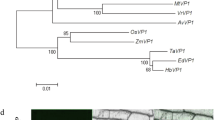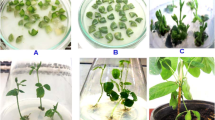Abstract
One of the widest ranging abiotic stresses in world agriculture arises from low iron (Fe) availability due to high soil pH, with 30% of arable land too alkaline for optimal crop production. Rice is especially susceptible to low iron supply, whereas other graminaceous crops such as barley are not. A barley genomic DNA fragment containing two naat genes, which encode crucial enzymes involved in the biosynthesis of phytosiderophores, was introduced into rice using Agrobacterium-mediated transformation and pBIGRZ1. Phytosiderophores are natural iron chelators that graminaceous plants secrete from their roots to solubilize iron in the soil. The two transgenes were expressed in response to low iron nutritional status in both the shoots and roots of rice transformants. Transgenic rice expressing the two genes showed a higher nicotianamine aminotransferase activity and secreted larger amounts of phytosiderophores than nontransformants under iron-deficient conditions. Consequently, the transgenic rice showed an enhanced tolerance to low iron availability and had 4.1 times greater grain yields than that of the nontransformant rice in an alkaline soil.
This is a preview of subscription content, access via your institution
Access options
Subscribe to this journal
Receive 12 print issues and online access
$209.00 per year
only $17.42 per issue
Buy this article
- Purchase on Springer Link
- Instant access to full article PDF
Prices may be subject to local taxes which are calculated during checkout





Similar content being viewed by others
References
Marschner, H. Mineral nutrition of higher plants, Edn. 2. (Academic Press, London, UK; 1995).
Takagi, S. Naturally occurring iron-chelating compounds in oat- and rice-root washing. I. Activity measurement and preliminary characterization. Soil Sci. Plant Nutr. 22, 423–433 (1976).
Mihashi, S. & Mori, S. Characterization of mugineic-acid-Fe transporter in Fe-deficient barley roots using the multi-compartment transport box method. Bio Metals 2, 146–154 (1989).
Römheld, V. & Marschner, H. Evidence for a specific uptake system for iron phytosiderophores in roots of grasses. Plant Physiol. 70, 175–180 (1986).
Mori, S. & Nishizawa, N.K. Methionine as a dominant precursor of phytosiderophores in Gramineae plants. Plant Cell Physiol. 28, 1081–1092 (1987).
Shojima, S., Nishizawa, N.K. & Mori, S. Establishment of a cell-free system for the biosynthesis of nicotianamine. Plant Cell Physiol. 30, 673–677 (1989).
Shojima, S. et al. Biosynthesis of phytosiderophores: in vitro biosynthesis of 2′-deoxymugineic acid from l-methionine and nicotianamine. Plant Physiol. 93, 1497–1503 (1990).
Higuchi, K., Kanazawa, K., Nishizawa, N.K. & Mori, S. The role of nicotianamine synthase in response to Fe nutrition status in Gramineae. Plant Soil 178, 171–177 (1996).
Kanazawa, K. et al. Nicotianamine aminotransferase activities are correlated to the phytosiderophore secretions under Fe-deficient conditions in Gramineae. J. Exp. Bot. 45, 1903–1906 (1994).
Takahashi, M. et al. Cloning two genes for nicotianamine aminotransferase, a critical enzyme in iron acquisition (strategy II) in graminaceous plants. Plant Physiol. 121, 947–956 (1999).
Akiyama, K. et al. Development of a system of rice transformation with long genome inserts for their functional analysis for positional cloning. Plant Cell Physiol. Suppl. 38, s94 (1997).
Higuchi, K. et al. Nicotianamine synthase gene expression differs in barley and rice under Fe-deficient conditions. Plant J. 25, 159–168 (2001).
Mori, S. et al. Why are young rice plants highly susceptible to iron deficiency? Plant Soil 130, 143–156 (1991).
Kanazawa, K., Higuchi, K., Nishizawa, N.K., Fushiya, S. & Mori, S. Detection of two distinct isozymes of nicotianamine aminotransferase in Fe-deficient barley roots. J. Exp. Bot. 46, 1241–1244 (1995).
Takizawa, R., Nishizawa, N.K., Nakanishi, H. & Mori, S. Effect of iron deficiency on S-adenosyl-methionine synthetase in barley roots. J. Plant Nutr. 19, 1189–1200 (1996).
Higuchi, K. et al. Cloning of nicotianamine synthase, novel genes involved in the biosynthesis of phytosiderophores. Plant Physiol. 119, 471–480 (1999).
Suzuki, K., Higuchi, K., Nakanishi, H., Nishizawa, N-K. & Mori, S. Cloning of nicotianamine synthase genes from Arabidopsis thaliana. Soil Sci. Plant Nutr. 45, 993–1002 (1999).
Okumura, N. et al. A dioxygenase gene (Ids2) expressed under iron deficiency conditions in the roots of Hordeum vulgare. Plant Mol. Biol. 25, 705–719 (1994).
Nakanishi, H. et al. Expression of a gene specific for iron deficiency (Ids3) in the roots of Hordeum vulgare. Plant Cell Physiol. 34, 401–410 (1993).
Nakanishi, H., Yamaguchi, H., Sasakuma, T., Nishizawa, N.K. & Mori, S. Two dioxygenase genes, Ids 3 and Ids 2, from Hordeum vulgare are involved in the biosynthesis of mugineic acid family phytosiderophores. Plant Mol. Biol. 44, 199–207 (2000).
Kobayashi, T. et al. In-vivo evidence that Ids 3 from Hordeum vulgare encodes a dioxygenase that converts 2′-deoxymugineic acid to mugineic acid in transgenic rice. Planta, in press (2001).
Okumura, N., Nishizawa, N.K., Umehara, Y. & Mori, S. An iron deficiency-specific cDNA from barley roots having two homologous cysteine-rich MT domains. Plant Mol. Biol. 17, 531–533 (1991).
Suzuki, K. et al. Formate dehydrogenase, an enzyme of anaerobic metabolism, is induced by Fe-deficiency in barley roots. Plant Physiol. 116, 725–732 (1998).
Yamaguchi, H., Nakanishi, H., Nishizawa, N.K., & Mori, S. Induction of the IDI1 gene in Fe-deficient barley roots: a gene encoding a putative enzyme that catalyses the methionine salvage pathway for phytosiderophore production. Soil Sci. Plant Nutr. 46, 1–9 (2000).
Yamaguchi, H., Nakanishi, H., Nishizawa, N.K. & Mori, S. Isolation and characterization of IDI2, a new Fe-deficiency induced cDNA from barley roots, which encodes a protein related to the α-subunit of eukaryotic initiation factor 2B (eIF2Bα). J. Exp. Bot. 51, 2001–2007 (2000).
Itai, R. et al. Induced activity of adenine phosphoribosyltransferase (APRT) in iron-deficient barley roots: a possible role for phytosiderophore production. J. Exp. Bot. 51, 1179–1188 (2000).
Chu, C. The N6 medium and its application to anther culture of cereal crops. In Proceedings of Symposium on Plant Tissue Culture, pp. 43–50. (Science Press,1978).
Kanazawa, K., Higuchi, K., Nakanishi, H., Nishizawa, N.K., & Mori, S. Characterizing nicotianamine aminotransferase: improving its assay system and details of the regulation of its activity by Fe nutrition status. Soil Sci. Plant Nutr. 44, 717–721 (1998).
Acknowledgements
We thank Dr. Pax Blamey in Queensland University for reading of this manuscript and Mr. Takeo Tanaka for his valuable assistance.
Author information
Authors and Affiliations
Corresponding author
Rights and permissions
About this article
Cite this article
Takahashi, M., Nakanishi, H., Kawasaki, S. et al. Enhanced tolerance of rice to low iron availability in alkaline soils using barley nicotianamine aminotransferase genes. Nat Biotechnol 19, 466–469 (2001). https://doi.org/10.1038/88143
Received:
Accepted:
Issue Date:
DOI: https://doi.org/10.1038/88143
This article is cited by
-
OsUGE2 Regulates Plant Growth through Affecting ROS Homeostasis and Iron Level in Rice
Rice (2024)
-
A lignin-derived material improves plant nutrient bioavailability and growth through its metal chelating capacity
Nature Communications (2023)
-
Beyond the snapshot: identification of the timeless, enduring indicator microbiome informing soil fertility and crop production in alkaline soils
Environmental Microbiome (2022)
-
Linking genome wide RNA sequencing with physio-biochemical and cytological responses to catalogue key genes and metabolic pathways for alkalinity stress tolerance in lentil (Lens culinaris Medikus)
BMC Plant Biology (2022)
-
Simultaneous Enhancement of iron Deficiency Tolerance and Iron Accumulation in Rice by Combining the Knockdown of OsHRZ Ubiquitin Ligases with the Introduction of Engineered Ferric-chelate Reductase
Rice (2022)



